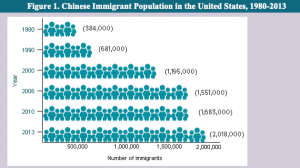Chinese Immigration
Learn more about: History of Chinese Immigration.
History of Chinese immigration to America is separated into two parts: the first wave being between the 1850’s and 1880’s and the second wave being from the 1970’s to the present. In the 1800’s economic issues at home and political problems within the country caused people to migrate to America to find work. Hong Kong nationals started the movement in the late 1900’s. Today, 1 in 10 of all Chinese immigrants to America are coming from Hong Kong. 21% of all Chinese immigrants to America are settling in New York, with Queens County and Kings County being the top two most settled places.
Hooper, Kate and Jeanne Batalova. “Chinese Immigrants in the United States.” Immigration Research Library, 28 Jan. 2015, www.immigrationreasearch.org/system/files/Chinese_Immigrants_in_the_United States.pdf
Learn more about: Chinese Immigration to New York.
“Chinese immigrants have been settling in New York for so many generations that the city is now home to the largest ethnic Chinese population outside of Asia… Starting in the 1960s, the U.S. re-opened the door to Chinese immigrants, who have arrived in increasing numbers from different parts of China, and settled all over New York—not just in Manhattan’s historic Chinatown.”
Walker, David. “Chinese Immigrants in New York.” PDN Photo of the Day, 23 Jan. 2019, potd.pdnonline.com/2019/01/55143/.
Asian American Literature: Book Stores and Publishers
 Learn more about: Asian American Literature.
Learn more about: Asian American Literature.
Asian American Writers Workshop – A national non-profit writers organization focused on creating, developing, and publishing creative writing by Asian Americans. Located in New York. University of Hawaii Press – Publisher of books and journals on Asian, Asian American, and Pacific Studies. Kaya – An independent press and publisher of “Asian/diasporic literature and culture.” They offer a range of texts that wouldn’t normally be found in commercial bookstores.
Girl In Translation’s Homepage
Taylor Vaca ’19



